
A sunny Ascot Racecourse (Kurt Pacaud / Bigstockphoto.com)
UK racing fans are amongst the most fortunate in the world, with the equine action on these shores being the envy of many other nations. Be it on the flat or over jumps, the British and Irish racing scene can be counted upon to provide a consistent stream of quality contests throughout the season.
However, what isn’t quite so consistent in this part of the world – and almost certainly won’t be the envy of too many other nations – is the weather. Sun, rain, wind, snow and hail, we have it all, and often in varying and unpredictable quantities, sometimes all on the same day! Of course, it has been this way for centuries now and, for the most part, the good old Brits manage to soldier on in the face of the elements – a statement which largely applies to the sporting world, including that of horse racing.
This is not always the case though. Despite the many years of history in battling the climate, and all the necessary precautions and preparations being taken, sometimes Mother Nature does come out on top – conjuring up conditions that really make racing impossible (or very dangerous). Frustrating as this may be – in terms of lost income for the racecourses, jockeys and bookmakers, and a reduction in the quantity of entertainment for us punters – the safety of the runners and riders must come first.
So, what exactly are these most inhospitable racing conditions? And why exactly do they cause meetings to be abandoned? Let’s take a closer look at those times when racing and the weather lock horns, and it is racing which is forced to retire to the stable and wait for another day.
Rain Stopped Play: Waterlogged Track
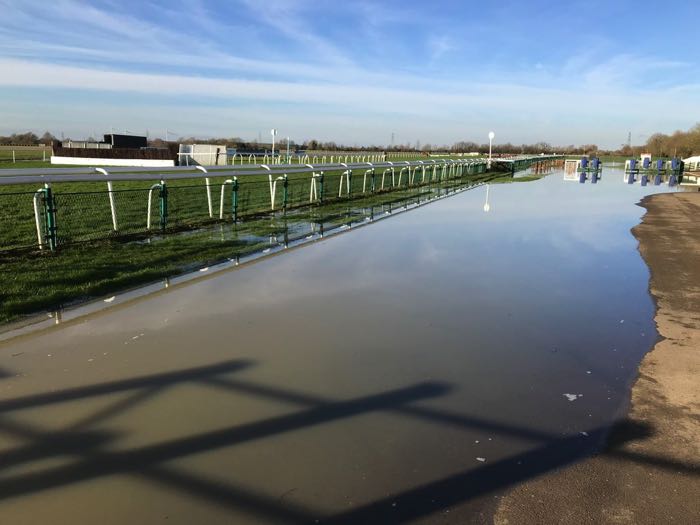
Huntingdon Racecourse flooded (Richard Humphrey / geograph.org.uk)
When it comes to weather conditions forcing the abandonment of a day’s racing action, comfortably the most common culprit is the rain. This should come as no surprise really considering the amount of it we seem to get on these shores. Of course, some horses thrive in testing conditions, and like nothing more than to see the mud flying. However, just as many simply don’t handle it at all – a fact emphasised by the significantly lower average field sizes on heavy ground compared to those on good going.
Irrespective of the likely field size implications, a track will always strive to hold a scheduled meeting if at all possible; the vast majority of turf courses being perfectly capable of coping with a significant downpour and happy to race on soft or heavy ground. Bearing that in mind, it is safe to assume that whenever we see a meeting called off due to a waterlogged track, it really is very wet indeed.
When the term waterlogged is used to describe a racing surface, it means exactly what you might expect. We are speaking of almost bottomless conditions, likely to provide an unfairly gruelling experience for even the most stamina-laden of performers. In some instances, there may even be standing water on sections of the track – creating a real risk of injury due to the difficulty of anticipating the depths of any upcoming pools. Whilst it is true that many horses are ideally suited to significant give underfoot, there aren’t too many who will be rushing from their box to slog through bog-like conditions and wade around the bends!
Snow Way They Can Race in That!
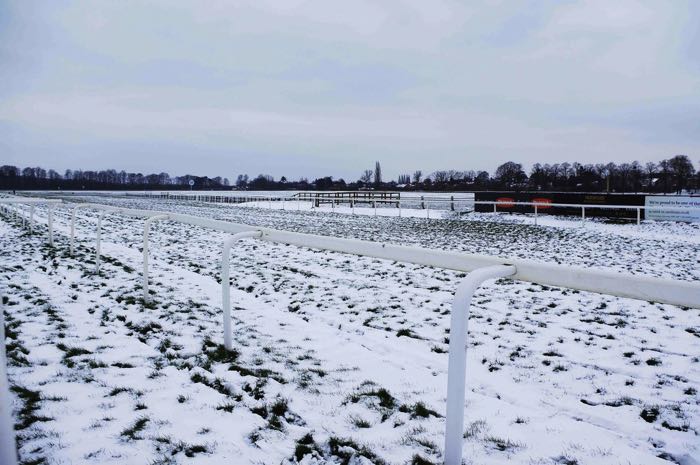
A snowy Worcester Racecourse (P L Chadwick / geograph.org.uk)
Rain may be the most common type of precipitation in the UK, but it is not the only one. We do also of course regularly receive our fair share of snow during the winter months. And whilst the white stuff may be a firm friend of children with sledges and aspiring snow artists, its relationship with horse racing is not quite so harmonious. In most instances, when the snow comes down in any kind of significant quantity, the racing stops.
There is one notable exception to the above, on “The White Turf” track at St Moritz, where the entire course is laid out on snowy terrain atop a frozen lake. That venue is however designed to be that way, featuring thick layers of soft snow which is thoroughly safety tested before racing.
A much thinner and uneven spread of snow sitting on top of a turf course – as occurs in the UK – is a different matter entirely. What is the ground like underneath the snow? Is it slippery? Frozen? Are certain parts of the course more affected than others? Quite simply there is no way of knowing for certain, and sending runners out to race on a snowy surface, which may or may not feature dangerous sections, is not an option. In addition to the potential slipping hazards, many horses can also experience snow balling together and hardening in the hoof which – in the absence of specialist shoes – can lead to increased risk of injury.
Frozen Out: Frost
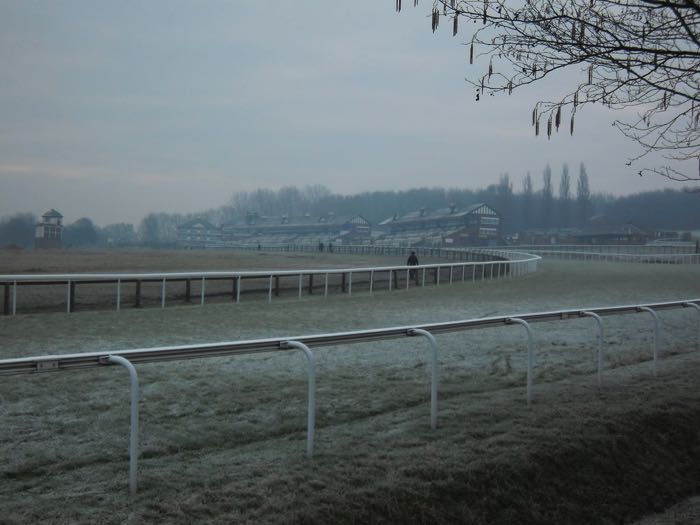
A frosty Pontefract Racecourse (derek dye / geograph.org.uk)
Of course, the snow doesn’t have to fall during the winter months for racing to be abandoned – sometimes sub-zero temperatures can be enough. For whilst many horses can cope with relatively firm ground conditions, asking a one-tonne beast to hurtle around on frozen, almost concrete-like terrain would bring an unacceptable likelihood of injury to both runner and rider – particularly as the vast majority of events held during the chilly winter months are jumps contests.
Add in the fact that such a frozen track is also likely to feature patches of slippery ice, and the decision to abandon meetings in such conditions is the only serious option – even if only sections of the track are frostbitten.
Hard Times: Firm Ground
Related to frozen ground, but at the opposite end of the UK temperature scale, are those occasions when the ground becomes too hard to race upon, not due to being frozen solid, but rather as a result of sustained high temperatures and a lack of precipitation. A rare occurrence in Britain admittedly, but it does happen from time to time.
One thing to note here is that the word “firm” is actually an acceptable going description to race upon in the UK. Therefore, when firm ground is given as the reason for the abandonment of a meeting, what is really meant is “hard” ground. As with all other weather factors, the reason hard ground causes racing to be abandoned is to protect the safety of the participants. Given their weight, and relatively thin limbs relative to their size, horses simply aren’t designed to race full-throttle on a rock hard surface, and asking them to do so may result in injury.
In reality, such a hard surface is a real rarity in UK racing, as the majority of turf courses feature watering systems that enable course managers to guarantee ground that is no quicker than good to firm, even in the warmest of the summer months. The only real exceptions to this being Brighton, and particularly Bath, where very quick, firm ground is the norm.
Slippery When Wet: Slick Surface
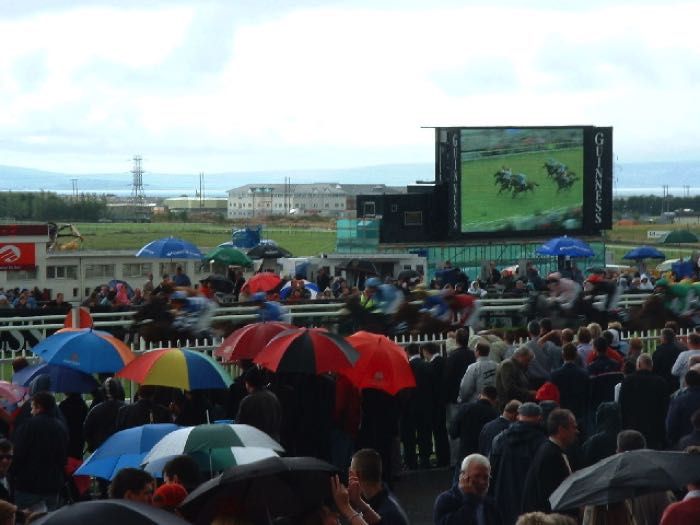
A rainy Ballybrit Racecourse (Robert Bone / geograph.org.uk)
As mentioned, to see a race abandoned due to the ground being too firm is a very unusual occurrence. The real danger with a firm, or even good to firm, surface can come when rain falls onto it. For whilst some tracks are quick to drain and will absorb the rainwater almost as soon as it falls, others feature a harder, less porous subsoil, creating a situation of slick wet grass sitting on top of a hard surface. And that can be a recipe for slipping, particularly as runners travel around the bends. Even one horse losing its balance whilst negotiating a turn at speed can spell disaster – with one such incident at Ayr in 2009 resulting in no fewer than seven of the 12 runner field being brought down – thankfully with no serious injuries.
This can be one of the more difficult scenarios to ward against, but improvements to the drainage at tracks with previous issues has helped. Should a runner slip due to an unsafe patch of ground at any point during a meeting, the remainder of that meeting will almost certainly be abandoned.
Blown Off Course: High Winds
Not so common as rain or frost-related abandonments, the wind can nevertheless derail racing’s best-laid plans from time to time. And sometimes on the biggest stage of all, with gale force conditions forcing Day Two of the Cheltenham Festival to be rescheduled in 2008.
Unlike with the other racing-related abandonments, it is not the safety of the horses themselves which is at greatest risk during extreme blustery conditions, but rather that of the spectators at the track.
In addition to their permanent buildings, many racecourses have a number of temporary fixtures in place on race-day, including hospitality tents, bars and eateries – many of which are in serious peril of being blown around the course when the wind speed reaches 40mph and over. Of most danger to the racegoers in the stands and enclosures, there is also the risk of disaster should such an item – or anything else for that matter – be blown onto the track during a race. In the face of such conditions, the only real option is to draw stumps and wait for another day.
Nothing to See Here: Fog
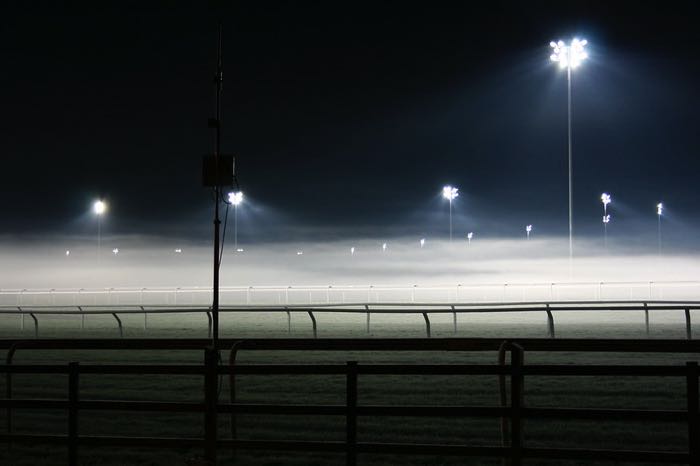
A foggy Kempton Park Racecourse (Kieran Messenger / Flickr.com)
There aren’t too many activities to which fog is conducive, and horse racing certainly isn’t one of them. A mild mist is manageable, but when an impenetrable “pea-souper” descends upon a course it leaves officials with little option but to call off the day’s action. In such conditions, you tend to be fortunate if you can see more than a few feet in front of you – not ideal during a flat contest, and simply asking for trouble in a jumping event.
And what about the spectators at the track, or even those tuning in on TV? Part of the thrill of watching the racing is of course the ability to track the runners throughout the race and during the pulsating finish. An unmoving blanket of grey tends to be somewhat less rewarding for those looking on.
A couple of quotes taken from a commentary by Jerry Hannon during a fog-addled contest at Punchestown in 2020 perhaps sum up the difficulties presented best of all…. “I’m not overly sure of their current location at this point,” rapidly followed by, “I think I can hear them coming down the home straight now.” Needless to say, the meeting was abandoned soon after.
Blinded by the Light: Low Sun
Thankfully it isn’t always raining, snowing or blowing a gale in England. We do also receive the occasional burst of sunshine. Welcome as this is to the natives, the sun can also bring its own problems to the racing world, and specifically in the realm of National Hunt racing.
On most occasions, the sunshine is a wonderful addition to a day at the races. However, issues can arise when the sun is lying low and shining almost directly into the eyes of the runners and riders. More of an inconvenience than anything in flat events, this scenario can prove a real health hazard in jumps contests. Jumping hurdles and fences is a tricky task at the best of times, doing so whilst half-blinded by the glaring sunshine greatly increases the chances of the competitors coming unstuck. Whilst it is rare for low sun to result in a meeting being abandoned, it can nevertheless dramatically alter the conditions of a race, due to the removal of those obstacles most badly affected.
All-Weather? Not Quite
Britain’s turf racecourses may be particularly vulnerable to the rigours of the British climate. But what about the six “All-Weather” tracks at Chelmsford, Kempton, Lingfield, Newcastle, Southwell, and Wolverhampton. Surely if they are to live up to their billing, these sand and synthetic fibre based tracks should be capable of standing firm in the face of everything Mother Nature hurls at them. But can they?
First things first, the all-weather surfaces are more able to withstand most forms of weather than their turf counterparts. The key word in that sentence though is “most”. All-weather tracks aren’t quite infallible and, to the consternation of racing fans, are indeed forced to abandon fixtures from time to time due (slightly embarrassingly) to the weather.
Extremely Cold Temperatures
Extreme cold temperatures can wreak havoc with all-weather surfaces due to snow thawing, seeping into the track and then refreezing within the surface as the temperatures drop again, creating an uneven, hard surface with frozen sections.
This is hardly conducive to safe racing. And even when the snow doesn’t thaw, it can be very difficult to remove it from the surface due to becoming mingled with the sand-like materials used on the track. Rather than attempting to remove the resulting sloppy terrain, organisers often opt to instead wait for another day.
Particularly Wet Periods
Rain is much less of an issue and it is really in this area that the all-weather tracks do come up trumps, with the surfaces enjoying excellent drainage and being capable of maintaining a raceable surface even following a substantial downpour. During particularly wet periods the going description at an all-weather venue may be altered from standard to standard/slow, but it is very rare for a meeting to be abandoned due to rain.
Fog
Of the other phenomena discussed, the all-weather is similarly vulnerable to the fog should it descend, although will be given a little more leeway in that regard due to the lack of jumping obstacles. The nature of the surface is however irrelevant in the face of extremely high winds, affording the tracks little protection should the gale force gusts arrive – a thankfully rare occurrence. Not quite all-weather then, but other than in real extremes, these tracks are significantly more resilient than their turf counterparts.
How Does a Weather Abandoned Meeting Affect Your Bet?
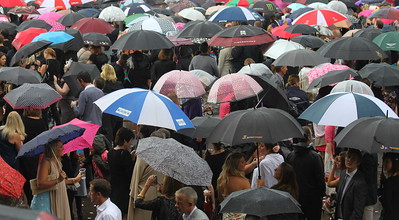
Rog Edwards / Flickr.com
Whilst on some occasions it can be clear from a very early stage that a meeting will succumb to the weather – with some fixtures being abandoned days in advance – at other times it can be a much more last-minute decision. One consequence of this is that at the time at which a meeting is abandoned, several bets will likely already have been placed on the scheduled action. So what happens to these bets?
There are really two rules relating to this – one which applies to standard bets, i.e. those placed on the day of the race itself or the day before, and another which applies to ante-post wagers, i.e. those made well in advance of the race.
Standard Bets
All standard bets will be voided and the stakes returned to the customer, with the only exception being if the race is rescheduled and takes place later on the same day, rather than being abandoned entirely. In this – extremely rare scenario – the bet will run as normal.
Ante-Post Bets
The rules for ante-post bets are slightly different. All ante-post bets will stand if the race is rescheduled to take place at a later date, so long as the race is set to take place at the original venue. In the event of a venue change, or if the race is cancelled entirely, all bets will be void and stakes will be returned to punters.
